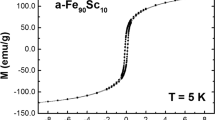Abstract
The concentration and temperature transitions in strongly correlated Fe1 – xCoxSi alloys with the Dzyaloshinski–Moriya (DM) interaction are considered in terms of the spin-fluctuation theory taking into account the results of LDA + U + SO calculations of the density of electronic states. It is shown that the concentration order–order transitions with change in the sign of the left spin chirality (at x < 0.2) to the right that (at x ≤ 0.2x < 0.65, and again to the left chirality at x ≥ 0.65 are related to the change in the sign of the parameter of the mode–mode interaction. It is also shown that, in the composition range of Fe1 – xCoxSi with 0.2 ≤ x < 0.65, the first-order transitions extended in temperature arise, accompanied by the appearance of an intermediate temperature range of the spin short-range order with a noncompensated local magnetization and the DM interaction. In an external magnetic field, in this temperature range at 0.2 ≤ x < 0.65, skyrmion microstructures arise. At x = 0.65, the mode–mode interaction parameter becomes be zero, the long-range order becomes ferromagnetic (since the experiment demonstrates the compensation of the DM interaction), and a temperature second-order transition appears instead of the extended first-order transition. The (h–T) diagrams of magnetic states of Fe1 – xCoxSi have been constructed; they agree with the experiment.





Similar content being viewed by others
Notes
As the sign of d is changed, the described conditions of the realization of the left or right magnetic chirality are changed to opposite.
REFERENCES
J. Beille, J. Voiron, F. Towfiq, M. Roth, and Z. Y. Zhang, J. Phys. F 11, 2153 (1981).
S. V. Grigoriev, V. A. Dyadkin, S. V. Maleyev, D. Menzel, J. Schoenes, D. Lamago, E. V. Moskvin, and H. Eckerlebe, Phys. Solid State 52, 907 (2010).
S.-A. Siegfried, E. V. Altynbaev, N. M. Chubova, V. Dyadkin, D. Chernyshov, E. V. Moskvin, D. Menzel, A. Heinemann, A. Schreyer, and S. V. Grigoriev, Phys. Rev. B 91, 184406 (2015).
J. Gayles, F. Freimuth, T. Schena, G. Lani, P. Mavropoulos, R. Duine, S. Blugel, J. Sinova, and Y. Mokrousov, arXiv:1503.04842v1 [cond-mat.mtrl-sci].
A. A. Povzner, A. G. Volkov, and T. M. Nuretdinov, Phys. Solid State 62, 873 (2020).
Y. Onose, N. Takeshita, C. Terakura, H. Takagi, and Y. Tokura, Phys. Rev. B 72, 224431 (2005).
E. Altynbaev, S.-A. Siegfried, E. Moskvin, D. Menzel, C. Dewhurst, A. Heinemann, A. Feoktystov, L. Fomicheva, A. Tsvyashchenko, and S. Grigoriev, Phys. Rev. B 94, 174403 (2016).
G. J. Li, E. K. Liu, H. G. Zhang, Y. J. Zhang, J. L. Chen, W. H. Wang, H. W. Zhang, G. H. Wu, and S. Y. Yu, arXiv: 1211.6815v1 [cond-mat.mtrl-sci].
A. Bauer, M. Garst, and C. Pfleiderer, Phys. Rev. B 93, 235144 (2016).
A. A. Povzner, A. G. Volkov, T. A. Nogovitsyna, and S. A. Bessonov, Phys. Solid State 62, 92 (2020).
I. E. Dzyaloshinskii and P. S. Kondratenko, Sov. Phys. JETP 43, 1036 (1976).
J. Hubbard, Proc. R. Soc. A 276, 238 (1963).
T. Moriya, Spin Fluctuations in Itinerant Electron Magnetism (Springer, Berlin, 1985).
A. A. Povzner, A. G. Volkov, T. M. Nuretdinov, and T. A. Nogovitsyna, Phys. Solid State 60, 1924 (2018).
A. A. Povzner, A. G. Volkov, and T. A. Nogovitsyna, Phys. Solid State 60, 230 (2018).
T. Y. Ou-Yang, G. J. Shu, C. D. Hu, and F. C. Chou, J. Appl. Phys. 117, 123903 (2015).
L. J. Bannenberg, K. Kakurai, F. Qian, E. Lelievre-Berna, C. D. Dewhurst, Y. Onose, Y. Endoh, Y. Tokura, and C. Pappas, Phys. Rev. B 94, 104406 (2016).
Funding
This work was supported by the Ministry of Education and Science of the Russian Federation, state task FEUZ-2020-0020.
Author information
Authors and Affiliations
Corresponding author
Ethics declarations
The authors declare that they have no conflicts of interest.
Additional information
Translated by Yu. Ryzhkov
Rights and permissions
About this article
Cite this article
Povzner, A.A., Volkov, A.G., Nogovitsyna, T.A. et al. Fluctuation-Induced Phase Transitions and Skyrmions in Strongly Correlated Fe1 – xCoxSi with a Disturbed Crystal B20-Type Structure. Phys. Solid State 63, 377–385 (2021). https://doi.org/10.1134/S1063783421030148
Received:
Revised:
Accepted:
Published:
Issue Date:
DOI: https://doi.org/10.1134/S1063783421030148




